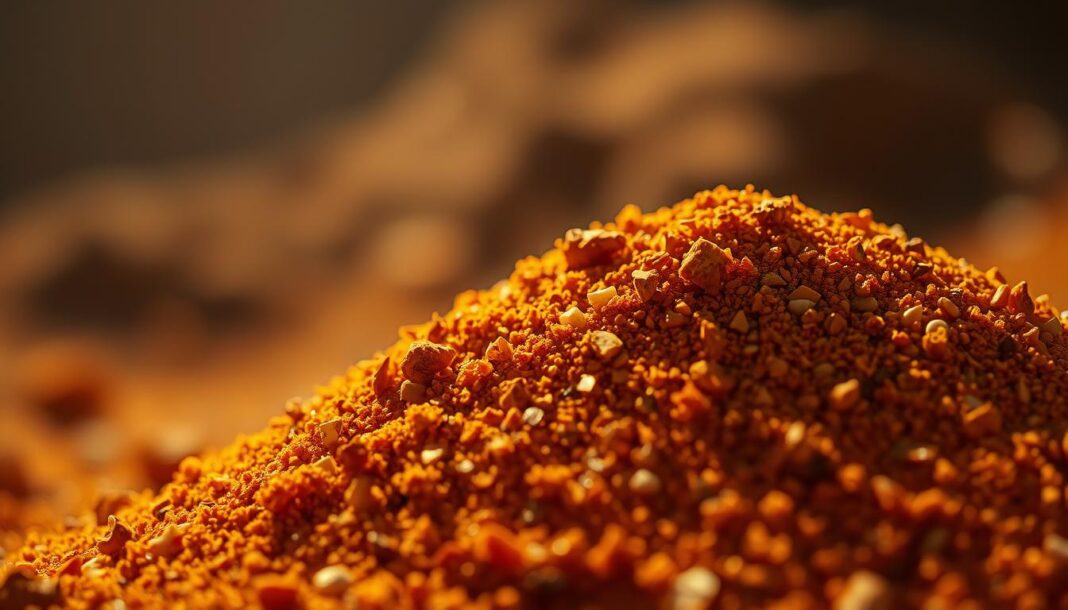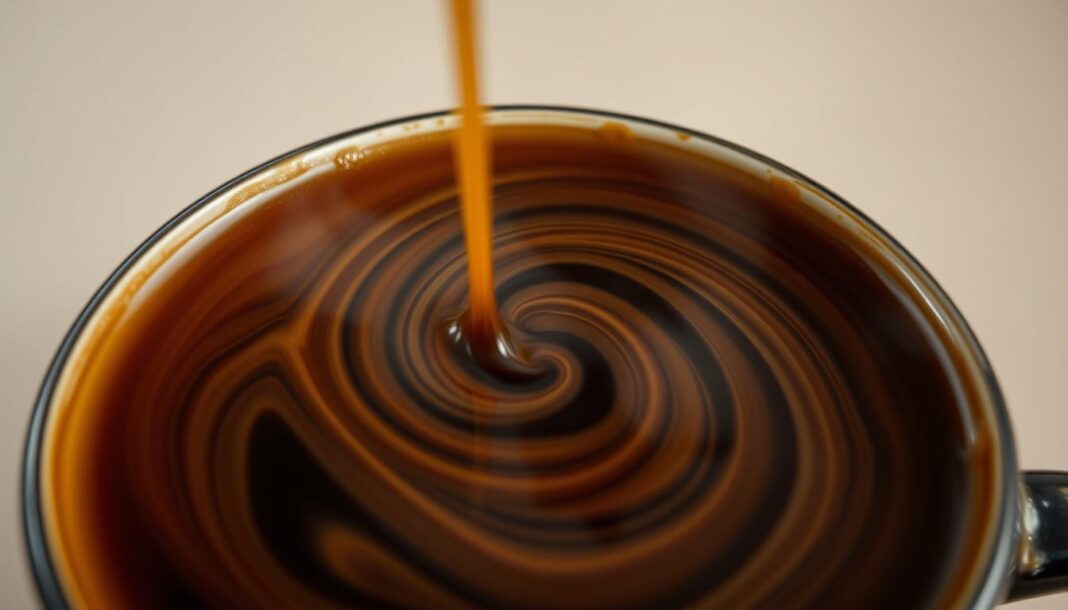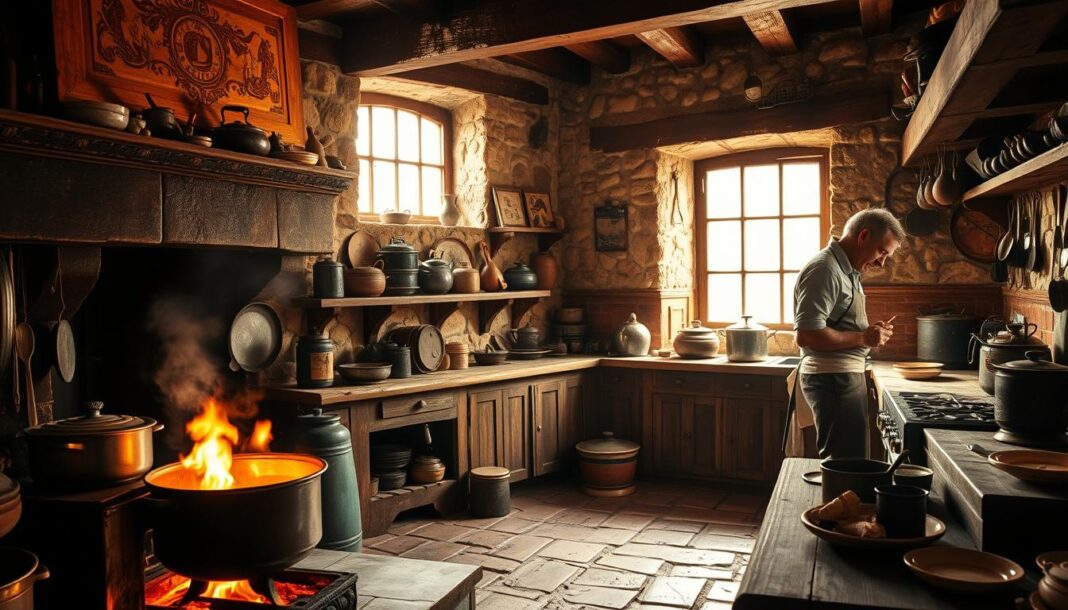Frank Herbert’s seminal science fiction series, Dune, is renowned for its intricate world-building and complex narrative. At the heart of this narrative is the fictional psychedelic drug known as melange, or “the spice.” This substance is not only the most valuable commodity in the Dune universe but also a catalyst for human evolution, granting users a longer lifespan, greater vitality, and heightened awareness.
We will explore how Herbert created a complex fictional substance with multiple dimensions—economic, political, religious, and physiological—that drives the entire narrative of the series. By examining the significance of spice in the Dune universe, we can draw parallels to historically significant spices and resources that shaped human civilization.
Key Takeaways
- The spice melange is a critical element in the Dune series, serving as a narrative device and metaphor for valuable resources.
- The substance has multiple dimensions, influencing economic, political, and religious aspects of the Dune universe.
- Herbert’s creation of melange draws parallels to real-world culinary traditions and the historical importance of spices.
- The spice grants users various benefits, including a longer lifespan and heightened awareness.
- The Dune series explores the consequences of relying on a rare and highly valuable substance.
The Essence of Melange: Dune’s Precious Resource
At the heart of Frank Herbert’s Dune series lies the enigmatic melange, a substance that has captivated readers with its mysterious properties and significance. This precious resource, also known as spice, is central to the narrative, influencing various aspects of the Dune universe.
Physical Properties and Appearance
The physical characteristics of melange are described vaguely throughout the Dune series. Herbert hints at its appearance in various books, noting that it can appear as a “dark reddish-brown” substance. In certain lighting conditions, melange exhibits a radiant blue glow, adding to its mystique. The appearance of spice melange is as fascinating as it is elusive.
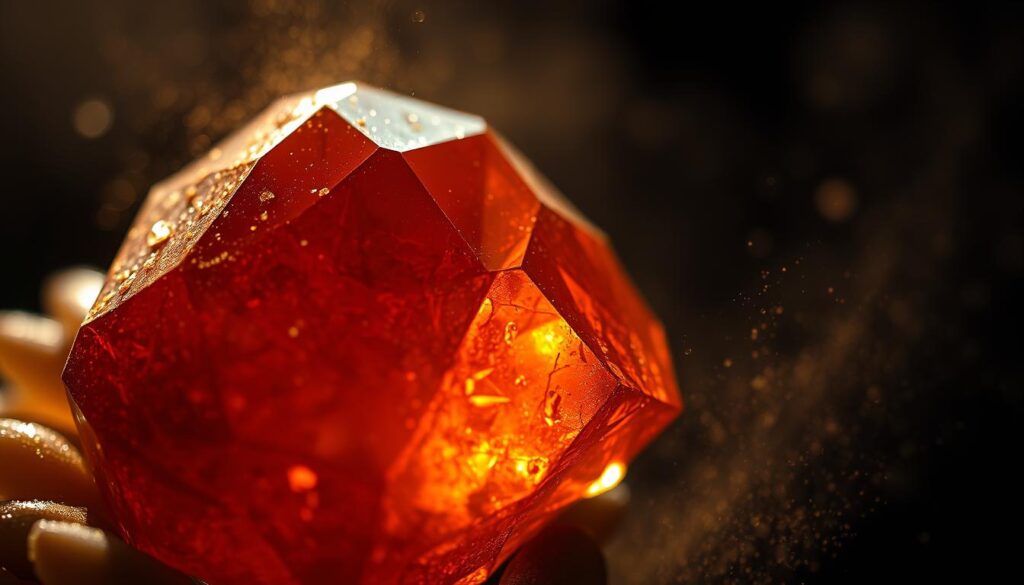
The Distinctive Cinnamon Aroma
One of the most recognizable traits of melange is its distinctive cinnamon aroma. Herbert consistently describes the smell of spice as similar to cinnamon, creating a vivid olfactory dimension to the fictional substance. This characteristic scent is a recurring theme throughout the series, making the spice even more alluring to the readers.
Consumption Methods in the Dune Universe
The consumption of melange varies widely in the Dune universe. From everyday dietary supplementation among the wealthy to the concentrated forms used by Guild Navigators and Bene Gesserit, spice is consumed in multiple forms. It is also incorporated into various foods and beverages, such as spice coffee, spice beer, and spice liquor, drawing parallels to how we use spices in our own culinary traditions.
As we explore the essence of melange, it becomes clear that its significance extends beyond its physical properties and use in the Dune universe. The variable quality of spice, described as tasting “never twice the same,” contributes to its mystique and value within the fictional universe, making it a truly unique and coveted substance.
The Origin and Production of Spice in Dune
Deep within the sands of Arrakis, a process unfolds that results in the creation of melange, the most valuable substance in the Dune universe. The planet Arrakis, also known as Dune, is a desert planet where the harsh environment and unique ecosystem give rise to this highly sought-after resource.
The Sandworm Lifecycle
The lifecycle of the sandworms on Arrakis is crucial to understanding the production of melange. The process begins with the sandtrout stage, microscopic creatures that encapsulate water, eventually transforming into giant sandworms. These sandworms can reach lengths of over 400 meters and play a vital role in the ecosystem by creating the conditions necessary for melange formation.
The sandtrout, described as “flat and leathery” creatures, are integral to this process. They encapsulate water, which is essential for the formation of the pre-spice mass. As the sandtrout mature into sandworms, they facilitate the creation of an environment conducive to the production of melange.
From Pre-Spice Mass to Melange
The formation of melange begins with the pre-spice mass, a stage of fungusoid wild growth achieved when water interacts with the excretions of “Little Makers,” the half-plant, half-animal vectors of the Arrakis sandworm. This interaction produces gases, resulting in a characteristic “blow” that brings the pre-spice mass to the surface. Upon exposure to sun and air, the pre-spice mass becomes melange.
The Dangerous Harvesting Process
Collecting melange is hazardous due to the attraction of sandworms to rhythmic activity on the desert surface. Harvesting is done using specialized equipment like Harvesters and Carryalls. The Fremen, indigenous to Arrakis, have developed manual harvesting techniques, contributing to their survival in the harsh environment.
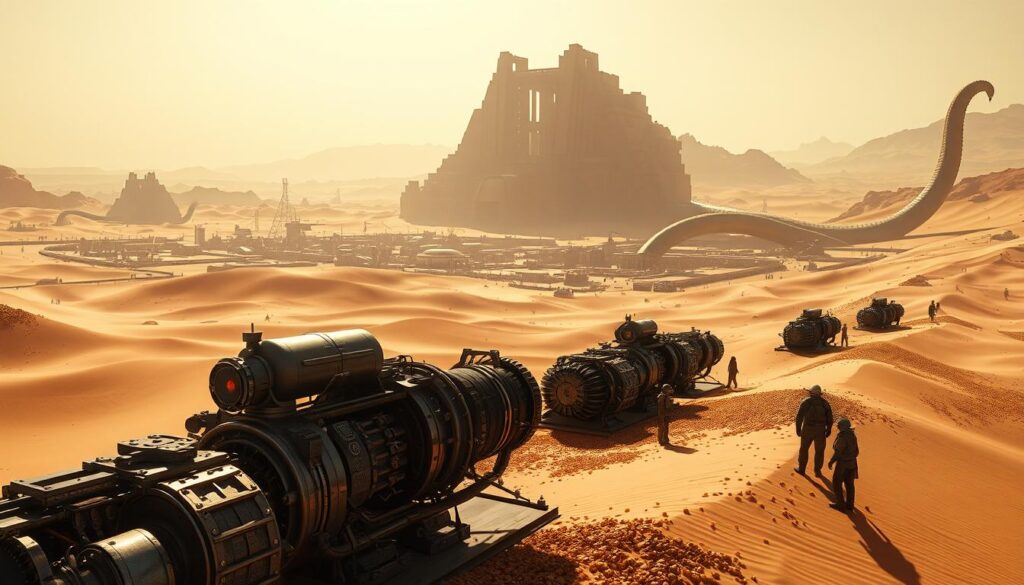
The production of melange is a complex process, intricately linked to the lifecycle of the sandworms and the ecosystem of Arrakis. Understanding this process is crucial to appreciating the value and significance of melange in the Dune universe.
- The sandworm lifecycle is crucial for melange production.
- The transformation from sandtrout to sandworms creates conditions necessary for melange.
- Harvesting melange is dangerous and requires specialized equipment.
Physiological and Psychological Effects
Melange, the rare and highly sought-after spice in Frank Herbert’s Dune, has various effects on those who consume it, ranging from enhanced health to altered states of consciousness. The substance is highly prized not only for its rarity but also for its ability to extend life and enhance cognitive abilities.
Life Extension and Health Benefits
The regular consumption of melange is known to significantly increase life expectancy and fortify overall health. Users who take the spice regularly can see their lifespan tripled, making it a virtual necessity for the wealthy and powerful in the Dune universe. This life-extending property is a result of the spice’s ability to enhance the body’s natural repair mechanisms and improve overall physiological function.
Health benefits of melange include not just longer life but also improved health levels, making it a highly sought-after substance for those who can afford it.
The Blue Eyes of Ibad Phenomenon
Sustained use of melange leads to a distinctive physical change known as the “Eyes of Ibad,” where the eyes turn a deep blue. This phenomenon is not just a physical marker of spice consumption but also a status symbol among certain groups like the Fremen. The blue eyes signify a deep physiological adaptation to the spice, indicating long-term use and a certain level of dependency.
Prescience and Expanded Consciousness
Heavy consumption of melange can unlock prescient abilities in genetically predisposed individuals, such as the Bene Gesserit and Guild Navigators. These abilities allow users to see into possible futures, navigate through complex spaces, and make predictions about future events. The spice enables an expanded consciousness that is crucial for navigating the complexities of interstellar travel and politics in the Dune universe.
The varying effects of spice on different groups—such as the Bene Gesserit, who use it for accessing genetic memories, and the Guild Navigators, who are physically transformed by massive exposure—demonstrate its complex and multifaceted nature as a substance that can both empower and enslave its users.
Economic and Political Power of Spice
The spice melange is the linchpin of the Dune universe’s intricate economic and political structure. Control of the spice melange is tantamount to control of the universe in the Dune saga, influencing every aspect of interstellar politics and economy. The rarity and versatility of melange make it a highly coveted resource, around which the entire interstellar society is organized.
The Spice Monopoly and Interstellar Travel
The spice monopoly is foundational to the political and economic order of the Dune universe. The Spacing Guild, with its reliance on Guild Navigators who consume melange to achieve prescience, is crucial for interstellar travel. This prescience allows them to safely navigate the complexities of folded space, making the spice indispensable for the functioning of the interstellar economy. The Guild’s dependence on melange effectively gives those who control Arrakis, the only source of spice, immense power over the galaxy.
Groups Dependent on Melange
Several key groups in the Dune universe are critically dependent on melange, creating a complex web of dependencies that reinforce the spice’s value. The Bene Gesserit sisterhood uses melange for their rituals and to enhance their powers, while the general population consumes it for its life-extending properties. The Spacing Guild’s Navigators rely on it for prescience, enabling them to navigate the dangers of interstellar travel. This widespread dependency ensures that control of the spice is tantamount to control of the universe.
| Group | Dependency on Melange | Significance |
|---|---|---|
| Spacing Guild | Guild Navigators consume melange for prescience to navigate folded space. | Critical for interstellar travel and commerce. |
| Bene Gesserit | Use melange for rituals and to enhance their powers. | Enhances their abilities and plays a role in their political influence. |
| General Population | Consume melange for its life-extending properties. | Contributes to the overall demand and value of melange. |
Control of Arrakis as Control of the Universe
Control of Arrakis, the sole source of melange, is effectively control of the universe. Paul Atreides’ seizure of Arrakis allows him to hold the entire interstellar civilization hostage through his monopoly on the most essential substance in existence. This dynamic underscores the theme of resource control and its implications for power and dependency in the Dune series. The value of melange, likened to “the combined worldwide value of cocaine and petroleum,” highlights the immense stakes involved in controlling this resource.
The parallels between the fictional spice economy and real-world resource monopolies are striking. Frank Herbert’s creation of melange as a substance of unparalleled value allows for an exploration of themes such as power, dependency, and resource politics, making the Dune series a rich and complex commentary on the human condition.
Historical Parallels: Earth’s Spice Trade
Frank Herbert’s Dune universe, with its rare and potent melange, has a historical mirror in the Earth’s spice trade, which has been a cornerstone of global commerce. The value and allure of spices have driven human history, shaping cultures, empires, and economies. We will explore these historical parallels, drawing insights from the spice trade’s impact on our world.
The Ancient Trade Routes
The Silk Road and other spice routes connected the East and West, facilitating not just trade but also cultural exchange. Spices like pepper, cinnamon, and nutmeg were highly valued, often used for culinary, medicinal, and even religious purposes. This historical network has its parallel in the interstellar trade of melange in Dune, where control of the spice dictates the balance of power across the galaxy.
Colonial Empires and the Spice Trade
European colonial powers built vast empires partly on the control of spice-producing regions. The quest for spices like cloves and nutmeg led to voyages of discovery, colonization, and conflict. Similarly, in the Dune universe, control of Arrakis and its melange is the central conflict driving the plot. The economic and political power conferred by control of a highly valued substance is a common theme between historical reality and Herbert’s fiction.
Luxury Spices: Melange and its Historical Counterparts
Melange, or “the spice,” in Dune is compared to historically valuable substances like saffron, which was once worth more than its weight in gold. These luxury commodities not only commanded high prices but also had significant social and economic impacts. The scarcity and unique properties of melange mirror the historical allure and value of rare spices, highlighting the universal themes of value, power, and control associated with rare and potent substances.
The Enduring Cultural Impact of Dune’s Spice
The concept of spice in Frank Herbert’s Dune has left an indelible mark on popular culture. As we have explored throughout this article, the spice melange is more than just a plot device; it’s a complex symbol that has influenced various aspects of modern media. From science fiction to video games and culinary trends, the impact of Dune’s spice is evident.
The sandworms of Arrakis, which produce the precious melange, have become iconic creatures in science fiction, symbolizing the dangers and rewards associated with valuable resources. Recent film adaptations, such as Dune and Dune: Part Two, have brought the visual spectacle of spice harvesting and sandworm encounters to new audiences, renewing interest in Herbert’s universe.
The themes associated with spice—addiction, power, resource control, and environmental impact—continue to resonate with contemporary audiences facing similar issues in the real world. By examining the cultural impact of Dune’s spice, we gain insights into our own relationship with precious commodities and the consequences of their exploitation. As a narrative device, the spice melange remains a powerful tool for exploring complex societal issues, ensuring its continued relevance in popular culture.
In conclusion, the enduring legacy of Dune’s spice serves as a testament to Frank Herbert’s visionary storytelling, continuing to captivate audiences and inspire new adaptations and interpretations.
